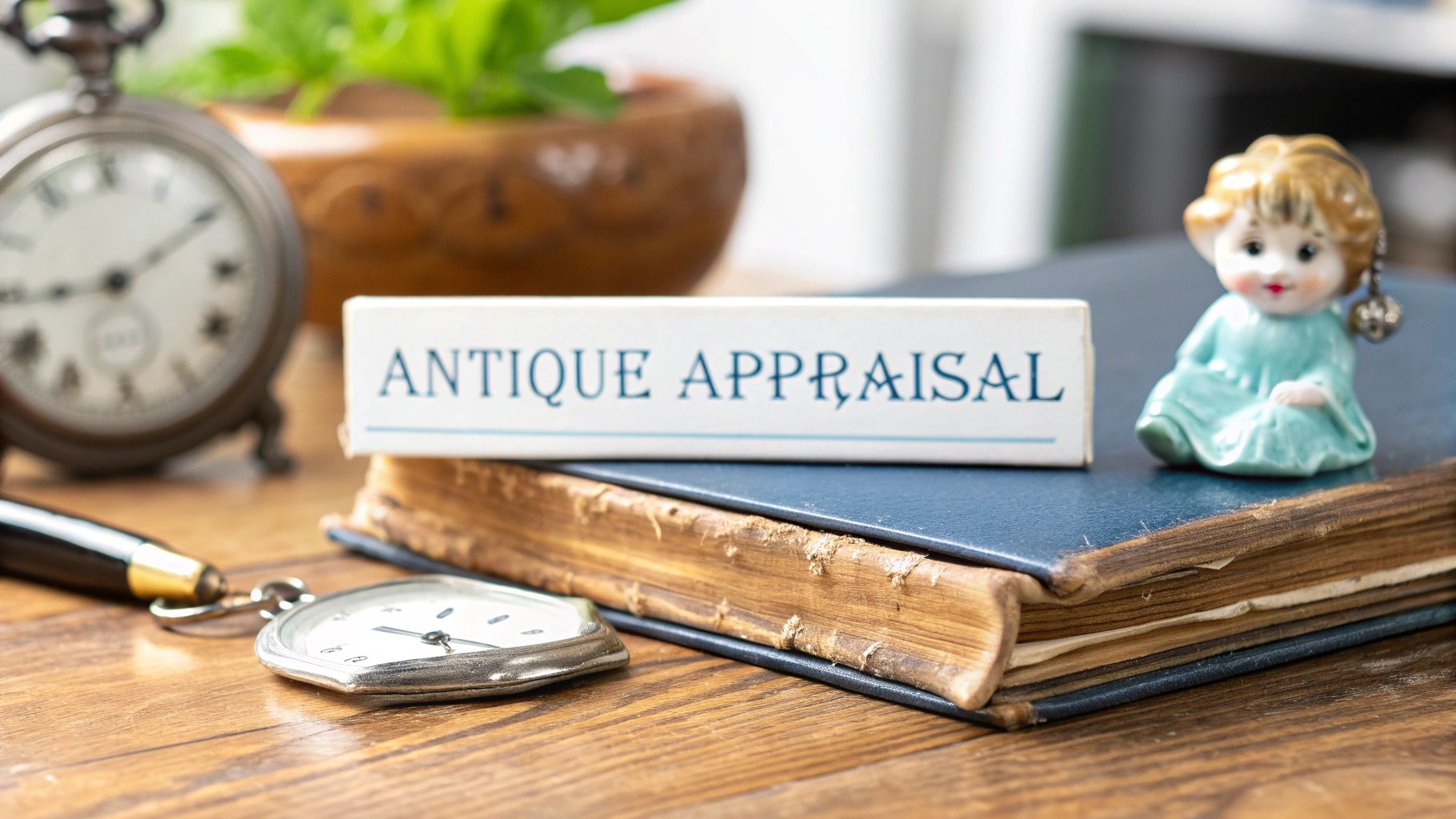So, what exactly is an antique appraisal service?
Think of it as hiring a private investigator for your heirlooms. Let's say you stumble upon an old, dusty painting in your grandmother's attic. Is it a priceless masterpiece or just a charming piece of family history? An appraiser is the expert who digs in to uncover the truth behind its story, authenticity, and actual market value.
This isn't just about slapping a price tag on something. A professional appraisal is a formal, in-depth process that gives you a legally defensible and thoroughly researched valuation. It’s the critical link between what an item means to you and what it’s actually worth on the open market.
An appraiser doesn’t just pull a number out of thin air. They meticulously investigate every detail—the item's condition, its maker, its age, and what similar pieces have recently sold for. The final product is a detailed report that doesn't just tell you what it's worth, but why.
What’s the Point of a Professional Valuation?
In short, an appraisal offers clarity and protection. Without one, you're essentially flying blind. You could end up insuring a priceless family treasure for pennies on the dollar or, worse, selling a rare collectible for a tiny fraction of its true value.
A formal appraisal from a reputable service is a must-have in a few key scenarios:
- Insurance Coverage: You need a replacement value appraisal to make sure you can replace an item if it's lost, stolen, or damaged. Your standard homeowner's policy probably won't cover the full value of unique antiques without this specific documentation.
- Estate Planning and Settlement: When it's time to divide assets among heirs, an appraisal ensures everything is fair and square, which can go a long way in preventing family disagreements. It's also the paperwork you'll need for tax purposes.
- Selling Your Antiques: A credible appraisal gives you serious negotiating power. It proves the item's value to potential buyers and helps you get a fair price, whether you're selling to a dealer, at an auction, or to a private collector.
- Charitable Donations: If you donate an antique to a museum or another non-profit, the IRS requires a formal appraisal to claim a tax deduction for items over a certain value.
An appraisal isn't just about finding out what something is worth today. It's about protecting that value for whatever comes next. It turns an unknown object into a documented asset, giving you both peace of mind and financial security.
Ultimately, getting an antique appraisal is an investment in knowledge. It gives you the confidence to make smart decisions, whether you're protecting a cherished heirloom for the next generation or getting ready to sell a piece you've loved for years.
Choosing the Right Type of Appraisal
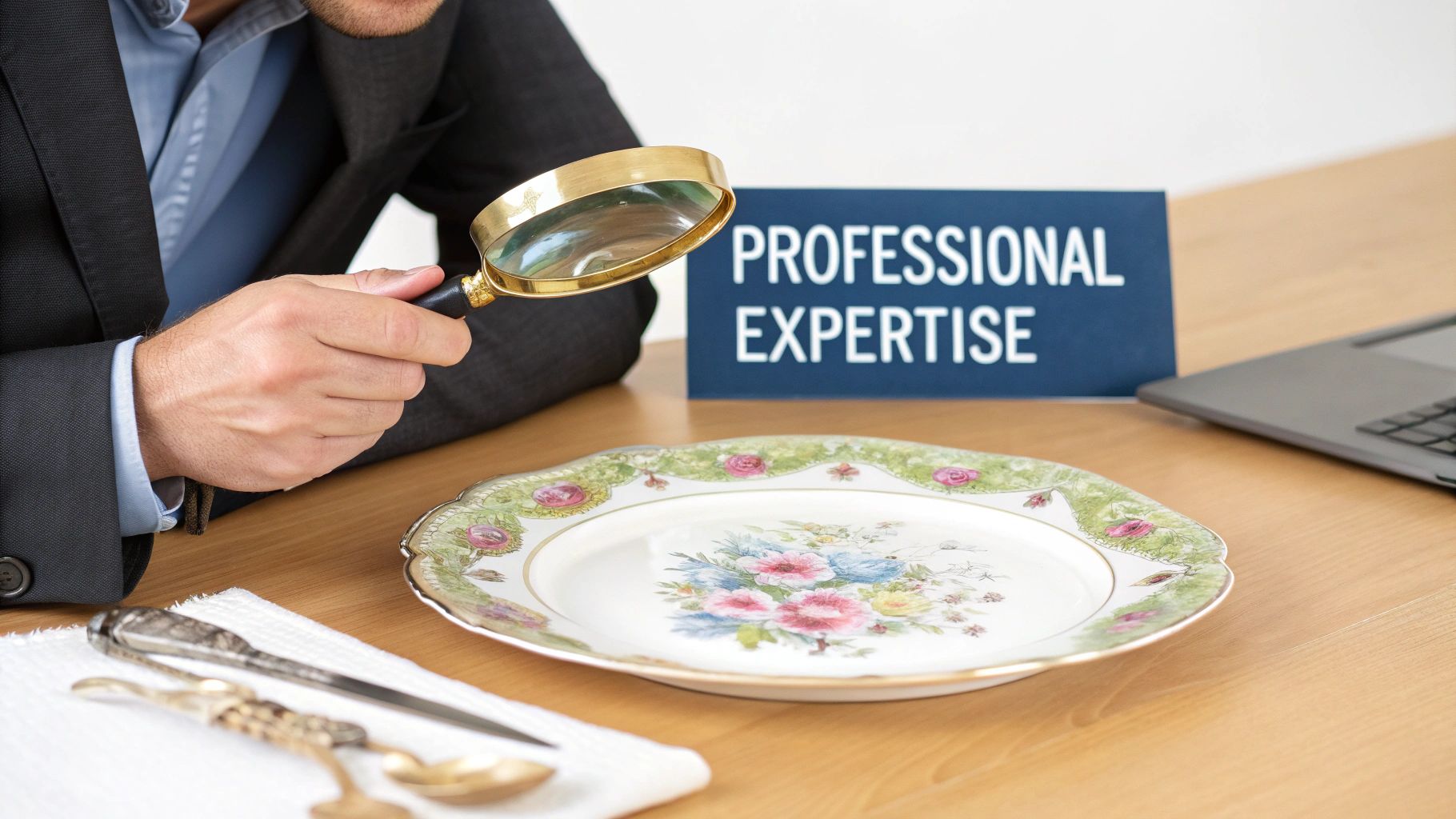
Here's a common myth I hear all the time: that every antique has one single, official price tag. The truth is, a single item can have several different—and equally correct—values. It all comes down to why you're asking.
Think of it like describing a car. You’d highlight its 0-60 time for a race, its safety rating for your family, or its gas mileage for a long road trip. The "value" changes with the context, and it's the exact same with antiques.
The value of a grandfather clock you want to insure is completely different from its value if you need to sell it quickly in an estate sale. Getting this right from the start is crucial. If you ask for the wrong kind of appraisal, you could end up overpaying for insurance or, even worse, getting short-changed in a sale.
Before you even pick up the phone to call an appraiser, you need to be crystal clear on your goal. This ensures they use the right framework to give you a number that actually helps you.
Fair Market Value for Sales and Donations
Most of the time, what people need is the Fair Market Value (FMV). This is the gold-standard figure representing what a willing buyer would likely pay a willing seller on the open market. It assumes neither party is in a rush and both know what they’re looking at. It’s the sweet spot—a realistic, balanced price.
You’ll want an FMV appraisal for things like:
- Private Sales: Figuring out a fair asking price when selling to another collector.
- Charitable Donations: The IRS requires an FMV appraisal for any non-cash donation worth over $5,000.
- Estate Taxes: This is the value used to calculate what an estate owes in taxes.
Simply put, FMV is what your item would probably sell for today under normal, unhurried conditions.
Replacement Value for Insurance Coverage
Now, let's talk about Replacement Value. This is almost always the highest number you'll see attached to your antique. It's not a sale price; it's the full retail cost to go out and buy a nearly identical piece from a specialized dealer right now.
Replacement Value isn’t what you could sell your item for; it's what it would cost to buy it again from a retail source. This higher figure ensures your insurance policy provides enough funds to make you whole after a loss.
This appraisal type is used for one thing and one thing only: insurance. An accurate Replacement Value is your safety net, making sure you’re properly protected against theft, fire, or accidental damage.
Liquidation Value for Quick Asset Conversion
Finally, we have Liquidation Value. This is the rock-bottom price you could expect if you have to sell something fast—and I mean fast. Think of a situation where an item absolutely must be sold within 30, 60, or 90 days. It's the lowest valuation because it assumes a forced sale, like at a no-reserve auction or a weekend estate sale where the main goal is to clear everything out.
You'd use a Liquidation Value appraisal for:
- Estate Settlements: When heirs need to sell assets quickly to divide the proceeds.
- Divorce Proceedings: To quickly value and split marital property.
- Bankruptcy: When assets must be turned into cash to pay off creditors.
Getting a handle on these different valuation methods is a huge step. To go even deeper, take a look at our complete guide on how to value antiques for modern collectors.
Comparing Appraisal Types and Their Uses
To make it even clearer, here’s a quick breakdown of the three main appraisal types. Think of this table as your cheat sheet for figuring out exactly what kind of valuation you need from an antique appraisal service.
| Appraisal Type | Valuation Basis | Primary Use Case |
|---|---|---|
| Fair Market Value | What a willing buyer would pay a willing seller in a stable market. | Selling an item, estate tax purposes, or charitable donations. |
| Replacement Value | The retail cost to replace the item with a similar piece from a dealer. | Insuring your antiques against loss, theft, or damage. |
| Liquidation Value | The price expected in a forced or hurried sale, like an auction. | Estate sales, divorce settlements, or bankruptcy proceedings. |
Knowing which one to ask for not only saves you time and money but also ensures the final report is perfectly suited for your needs, whether you're selling, insuring, or settling an estate.
Online Appraisals Versus In-Person Experts
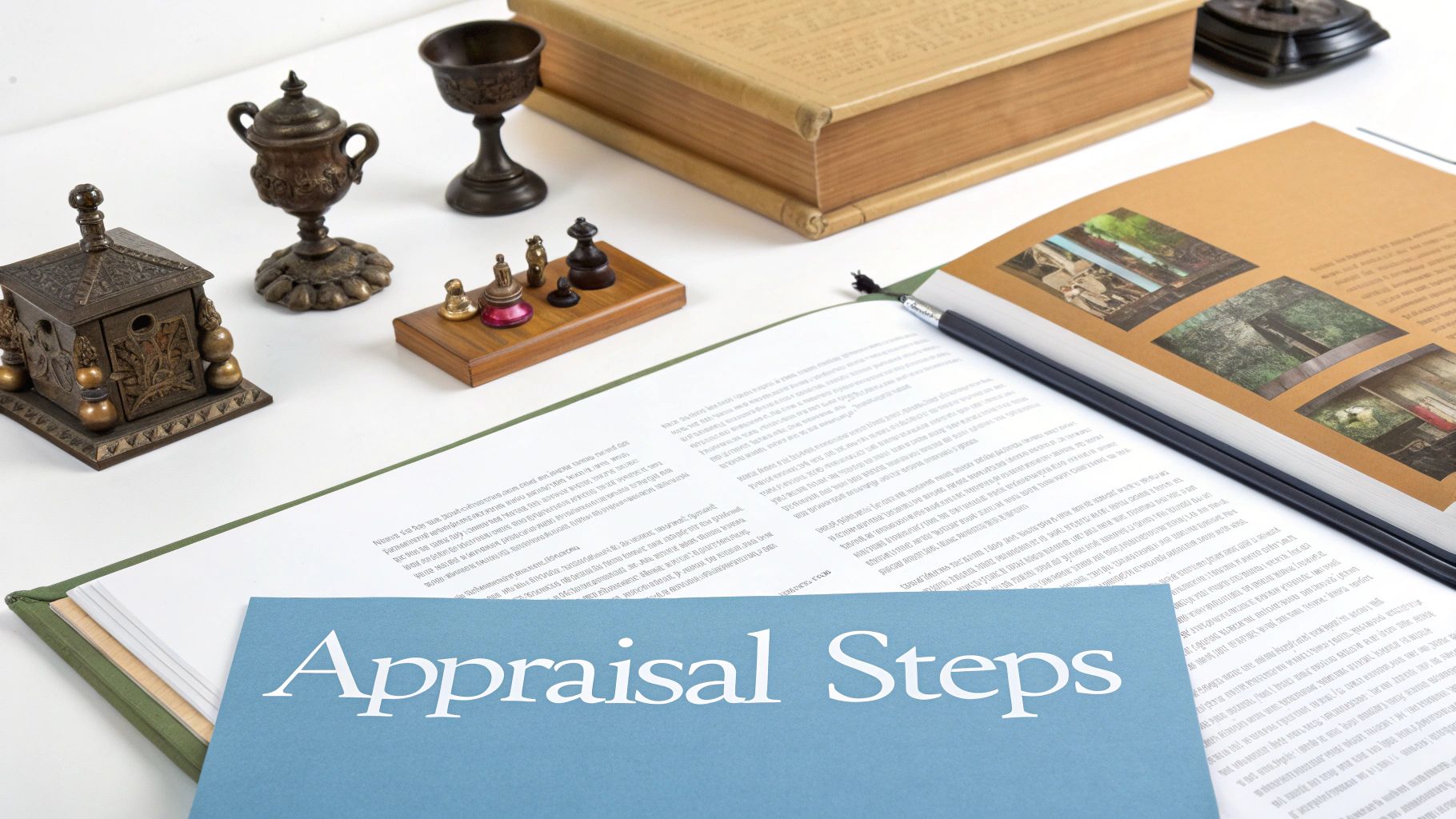
Deciding between an online appraisal and a traditional in-person expert is a lot like choosing between a quick video call with your doctor and a full-on physical exam. One gives you speed and convenience, while the other offers a depth of analysis you just can't get remotely. Both have their place, of course, but the right one for you really depends on what you have and what you need.
The antiques world has definitely gone digital, and that shift has changed how things are bought, sold, and valued. The global art and antique market saw online auctions more than double their share, hitting $12.4 billion back in 2020. That’s not just a blip; it shows a real move toward using digital platforms for everything, including appraisals. If you're curious about the numbers, you can dig into the full research from UBS on the art market.
This digital boom makes online appraisals incredibly easy to find. But it's important to understand what you're getting—and what you might be missing—when you choose a screen over a handshake.
The Case for Online Appraisals
Online appraisals are built for our modern, fast-paced lives. They're quick, they’re affordable, and you can get one from your living room. For a lot of people just starting out, this is the perfect entry point. The process couldn't be simpler: snap a few photos, write down any details you know, and an expert will get back to you with a valuation, usually within a day or two.
This approach is a lifesaver in a few key situations:
- Convenience and Speed: No need to leave the house. This is a huge win if you have something that's a pain to move, like a giant, fragile armoire or a heavy marble statue.
- Lower Cost: By cutting out travel and appointment times, online appraisals are almost always easier on the wallet. They’re a low-risk way to satisfy your curiosity.
- Quick Sorting: Got a whole attic full of stuff? An online service can help you quickly figure out which items are worth a closer look and which are just everyday objects.
But that convenience has its limits. An appraiser looking at photos can't feel the heft of a silver candlestick, inspect the hand-cut dovetails on a chest of drawers, or see a painter's subtle brushstrokes under a magnifying glass. For items where those tiny details matter, an online look might miss the very thing that makes your piece a rare treasure.
The Power of an In-Person Examination
An in-person appraisal is the gold standard for a reason. It's all about accuracy and detail. Think of it as a forensic investigation where an expert can use specialized tools, examine maker's marks up close, and feel the texture and condition in a way photos just can't replicate.
This hands-on approach is absolutely essential for high-stakes situations:
- Insurance and Legal Paperwork: If you need an appraisal for an insurance policy, estate settlement, or a charitable donation, you'll need a formal, signed report. These documents have to be rock-solid and legally defensible, which requires an in-person assessment.
- High-Value Items: If you have a feeling your item is truly special—a rare piece of jewelry, a signed painting, or an important historical artifact—an in-person evaluation is the only way to be certain of its value.
- Spotting Fakes: A seasoned expert can spot a clever forgery or telltale signs of a hidden repair that would be completely invisible in a photograph. That hands-on inspection can be the difference between an item being priceless or worthless.
The main trade-off is commitment. In-person appraisals cost more and take time to schedule. But for the right items, that investment buys you certainty and a level of detail an online service simply can't provide.
Making the Right Choice for Your Antique
So, what’s the right move for you? It all comes down to your item and your goal.
- Have a small porcelain doll you snagged at a flea market? An online appraisal is a perfect, low-cost way to see if you stumbled upon a hidden gem.
- Need to insure that huge dining room set you inherited? An in-person appraisal is non-negotiable to get the accurate replacement value your policy requires.
In the end, choosing an antique appraisal service isn't about which method is "better." It's about picking the right tool for the job. Take a good look at your item, your budget, and what you need the appraisal for. Once you do that, you'll know exactly which path will give you the confidence you need.
Understanding the Costs of an Appraisal
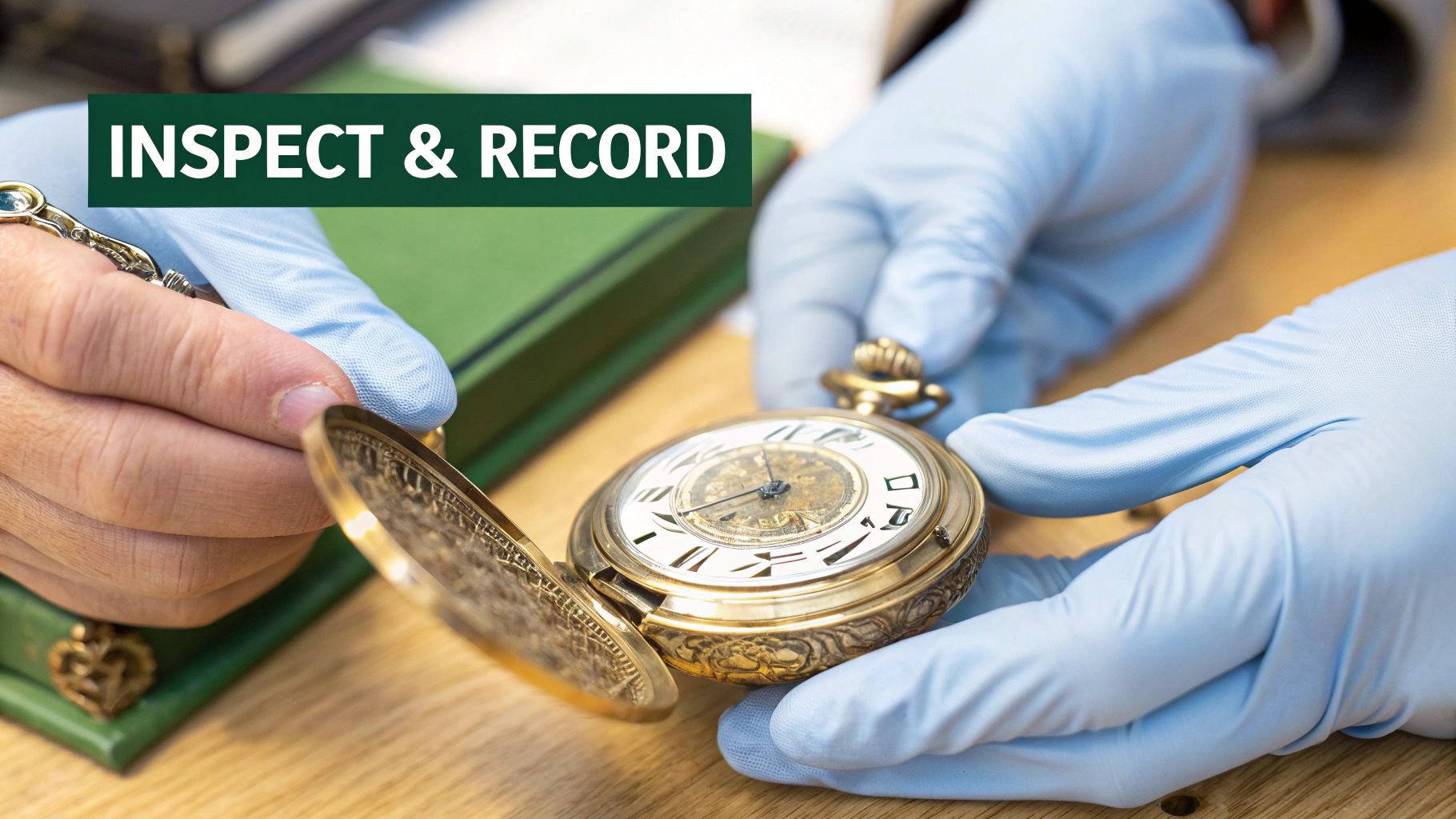
Let's talk about one of the first questions on everyone's mind: what does an antique appraisal service actually cost? It's a fair question, and the answer is simpler than you might think. You’re not paying a commission based on your item’s value; you’re investing in an expert’s dedicated time, specialized knowledge, and careful research.
Think of it this way: you're hiring a highly skilled consultant, not a salesperson. A trustworthy appraiser delivers an objective, unbiased valuation built on years of experience and deep market analysis. Knowing how they structure their fees helps you budget accordingly and, just as importantly, spot any red flags.
Common Fee Structures Explained
Most professional appraisers charge for their services in one of two ways. This transparency is key because it ensures their judgment remains impartial—their paycheck isn't tied to the dollar value they assign your piece.
Hourly Rates: This is the most common model you'll encounter. The appraiser bills for the total time spent on your project, which covers everything from the hands-on examination and research to market analysis and preparing the final report. Rates can vary quite a bit, typically ranging from $100 to over $400 per hour, depending on the appraiser's expertise and where they're located.
Flat Fees: For more straightforward jobs, an appraiser might quote a single, all-in price. A flat fee is perfect for appraising a single item or a small, clearly defined collection where the amount of work is easy to estimate upfront.
This kind of pricing structure means the appraiser's only motivation is to get it right, not to inflate a number to boost their own fee.
A Major Red Flag: Percentage-Based Fees
If an appraiser ever suggests charging you a percentage of your item's appraised value, your best move is to walk away. This practice is a serious ethical violation according to the Uniform Standards of Professional Appraisal Practice (USPAP), which sets the quality-control standards for the entire industry.
A fee based on a percentage of the value creates a massive conflict of interest. It gives the appraiser a direct financial incentive to inflate the valuation, which completely undermines their objectivity and results in a biased, unreliable report.
Reputable professionals never link their pay to an item's worth. Their value is in their expertise, not in the price tag of your antique. An appraiser asking for a percentage is a clear signal that you are not dealing with a certified, ethical professional.
Factors That Influence the Final Price
The cost of an appraisal isn't a one-size-fits-all situation. Several key factors can shift the final price, reflecting the time and resources needed to do the job right.
- Complexity of the Item: A common piece of sterling silver is far easier to research than, say, a rare, one-of-a-kind manuscript. The more unusual your item is, the more digging the appraiser has to do.
- Appraiser’s Specialization: An expert in a niche field, like 18th-century French furniture, will naturally command a higher rate than a generalist due to their highly specific knowledge.
- Travel Requirements: If an appraiser needs to come to you for an in-person examination, you can expect their travel time and expenses to be part of the final bill.
- Market Demand: The global collectibles market is booming and is predicted to hit around $902 billion by 2035. This surge in interest drives up demand for specialized appraisers, which can influence costs, especially for high-value items where the liability and insurance risks are greater. You can read more insights on the rising costs of antique appraisals on curio.app.
Understanding these variables makes it clear why one appraisal might cost much more than another. It's not just about the item's potential value, but about the work involved in accurately determining it. It's also helpful to know what kind of valuation you need; you can learn more in our detailed guide on what is fair market value. Once you understand these cost structures, you can confidently find an expert whose fees are fair and whose work you can trust.
How to Find a Reputable Antique Appraiser
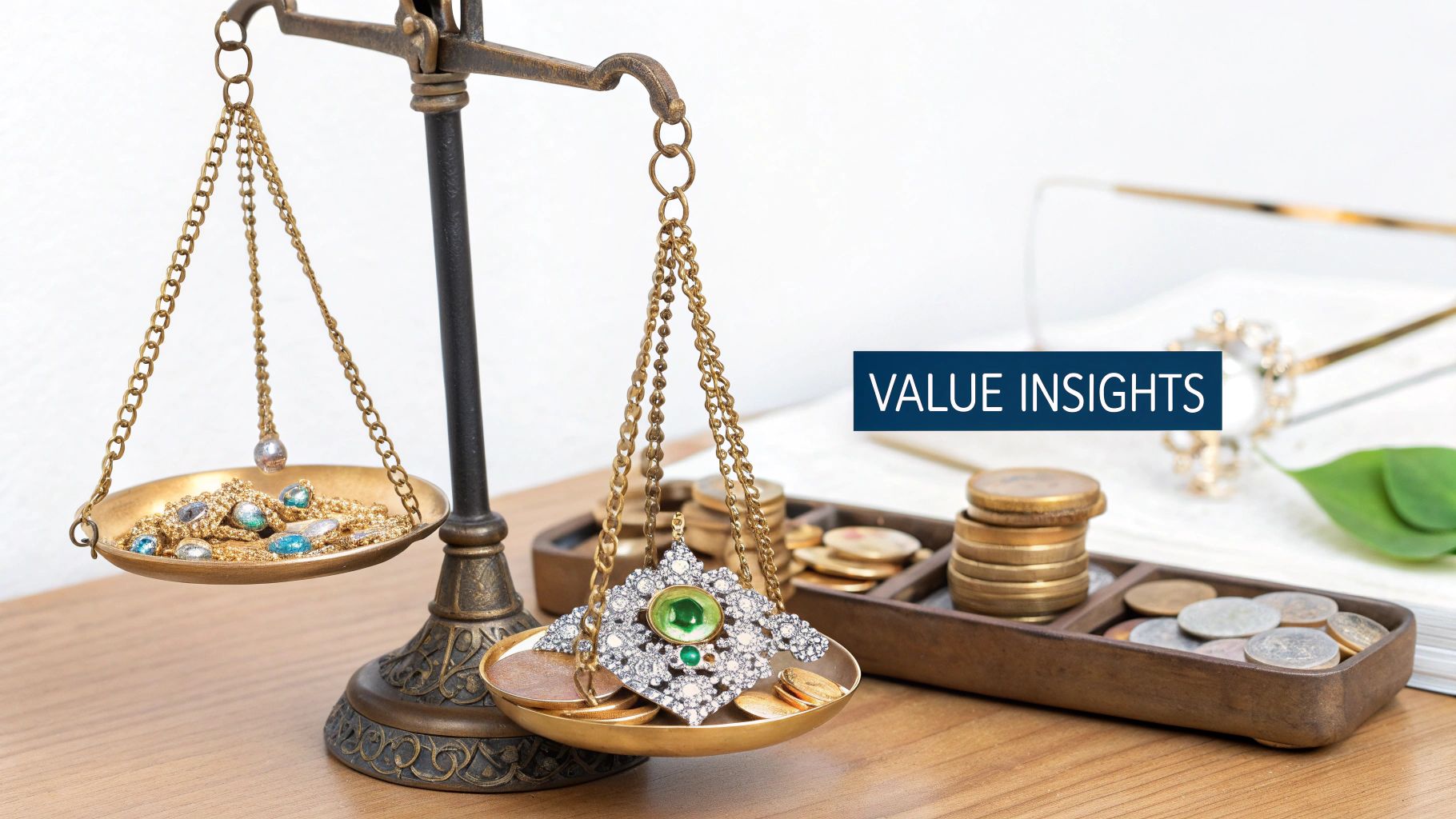
Finding the right person to evaluate your antique is, without a doubt, the most crucial part of the whole appraisal journey. A great appraiser gives you more than a price tag; they deliver an objective, thoroughly researched valuation that holds up to scrutiny. But with so many people calling themselves experts, how do you find a true professional?
Think of it like hiring any other highly skilled specialist. You wouldn't go to a family doctor for brain surgery. In the same way, you need an appraiser who has the right background and specific expertise for your item. The best place to start looking is with professional organizations—they’ve already done a lot of the vetting for you.
Start with Professional Organizations
The most reliable way to connect with a qualified expert is by going through established appraisal associations. These groups don't just let anyone join. Their members have to meet strict educational standards, pass rigorous exams, and follow a strict code of ethics. They’re really the gold standard in the industry.
Kick off your search with these three heavy hitters:
- Appraisers Association of America (AAA): A top-tier national association with a fantastic searchable database of certified appraisers in all sorts of specialties.
- International Society of Appraisers (ISA): Another highly respected group that offers deep training and certification for its members across countless fields.
- American Society of Appraisers (ASA): This organization covers many areas, including personal property, and its members are known for their intensive training and high ethical bar.
Using these organizations as your starting point helps filter out the noise and leaves you with a list of genuine professionals. If you’re leaning toward an online service, it’s also smart to check out guides that rank the https://www.curio.app/blog/12-best-antique-appraisal-online-free-services-for-2025 to see which platforms have a solid reputation.
Vet Your Candidates Thoroughly
Once you've got a shortlist of potential appraisers, it's time to dig a little deeper. This is where you confirm they have the right credentials and are a good match for what you need. The single most important thing to look for is USPAP compliance.
The Uniform Standards of Professional Appraisal Practice (USPAP) is the recognized set of ethical and performance standards for appraisers in the United States. A USPAP-compliant appraiser is sworn to provide an unbiased, objective, and confidential valuation. Never hire an appraiser who isn't USPAP compliant.
When you first talk to an appraiser, don't be shy about asking direct questions. A true professional will be happy to talk about their qualifications and will be totally transparent about their process.
Here are the essential questions you should ask:
- What are your credentials and certifications? You want to hear designations like AAA, ISA, or ASA.
- Are you USPAP compliant? This is a deal-breaker. The answer must be yes.
- What is your area of specialization? Make sure their expertise lines up with your item. Someone who specializes in 18th-century French furniture might not be the best fit for your mid-century modern lamp.
- How do you structure your fees? They should always charge a flat fee or an hourly rate. An appraiser who wants a percentage of the item's value has a conflict of interest.
- Can you provide references or examples of past work? Any experienced pro will have client testimonials or a portfolio ready to share.
Taking this direct approach will give you the confidence you need to choose an expert who can give you a credible, accurate, and ethical valuation for your piece.
Getting Your Items Ready for an Appraisal
A little prep work before you meet with an appraiser can make a world of difference. Think of it like getting your documents in order before tax season—the more organized you are, the smoother the process will be. Taking a few minutes to prepare helps the appraiser do their job efficiently, which can save you money and lead to a much more accurate valuation.
The most important first step? Collect every bit of paperwork you can find related to your item. This is what experts call provenance, and it’s basically your antique’s life story on paper.
Gather Your Item's Backstory
Provenance is the paper trail that proves an item's history, and a strong one can dramatically increase its value. Before you head to your appointment, see if you can dig up any of these documents:
- Original receipts or bills of sale showing when and where it was first purchased.
- Old family photos where the item might be sitting in the background.
- Letters, journals, or diary entries that mention the piece, like a note from a grandparent about receiving it as a wedding gift.
- Any previous appraisal documents, no matter how old they seem.
Even family stories passed down through generations can offer vital clues. Was the item brought over from the "old country"? Did a notable ancestor own it? Jot down these details to share with your appraiser.
What to Avoid Before an Appraisal
Just as crucial as what to do is what not to do. It’s a common mistake, but many people accidentally lower their antique's value by trying to “spruce it up” before getting it looked at. The golden rule here is simple: leave it alone.
An antique's value is deeply tied to its original condition. The patina, the signs of age, and even the dust tell a story that's critical for a proper valuation. Trying to "fix" it can erase that history forever.
Fight the urge to clean, polish, or repair anything. That layer of tarnish on a silver tray or the worn finish on an old wooden table gives an expert invaluable information about its age and authenticity. A good appraiser is trained to see past the surface grime to the true quality underneath. A DIY repair or a quick polish with the wrong cleaner can cause permanent damage.
By simply gathering your documents and bringing the item in its "as-is" state, you’re giving the appraiser exactly what they need. You’re handing them the puzzle pieces of its past, which allows them to build a complete and accurate picture of its true worth today.
A Few Common Questions
If you're new to the world of antique appraisals, you've probably got a few questions. That's completely normal. Let's walk through some of the most common things people ask, so you can feel confident about getting your treasures valued.
How Long Does an Appraisal Take?
Honestly, it really depends. The timeline for an antique appraisal service can be all over the map. For a straightforward item you submit online, you might get an answer back in a day or two. But if you have a rare piece that requires a formal, in-person look and a deep dive into research, it could easily take several weeks for the appraiser to do their due diligence.
Do I Really Need an Appraisal to Sell My Antique?
Technically, no. But should you get one? Absolutely. Think of it as your biggest advantage when you go to sell. An appraisal gives you a documented, expert opinion on value, which is a game-changer in negotiations.
Without that piece of paper, you're essentially guessing, and you could accidentally let go of an item for far less than its true Fair Market Value. An appraisal gives you the confidence to set a fair price and protects you from lowball offers.
An appraisal is your proof of value. It shifts the conversation from subjective opinion to objective fact, giving you a solid foundation for any sale negotiation and helping you secure the best possible price for your piece.
Are Auction Results a Good Indicator of Value?
Auction results are a useful piece of the puzzle, but they aren't the whole picture. The public auction market is huge—global art and antique sales topped $20 billion in 2024. The U.S. is a massive part of that, making up 31% of all sales in 2023, so what happens here definitely matters. You can discover insights about the global auction market on Statista.com.
But here’s the thing: an auction price is just a snapshot. It reflects what a specific group of bidders was willing to pay on one particular day. A professional appraiser looks at those results, but they also factor in private sales, what dealers are asking, and the overall health of the market to give you a much more stable and realistic valuation.
What Should I Expect in a Final Appraisal Report?
A real appraisal report is much more than just a number on a page. It's a formal, detailed document that backs up the valuation with solid evidence.
A proper report will always include:
- A Detailed Description: This covers everything from measurements and materials to maker's marks and a close look at the item's condition.
- Methodology: The appraiser will clearly state what type of value they determined (like Fair Market Value or Replacement Value) and explain the process they used to get there.
- Market Analysis: Here, you'll see data on what similar items have sold for and a breakdown of current market trends.
- Clear Photographs: Good-quality photos from several angles are essential for documentation.
- Appraiser's Certification: The report must be signed and dated by the appraiser, confirming it meets professional standards like USPAP.
This is the kind of thorough documentation that makes an appraisal a credible tool, whether you need it for insurance, estate planning, or selling.
Ready to uncover the story and value behind your items? Let Curio be your guide. With our easy-to-use app, you can get instant identification, historical context, and a quick appraisal right from your phone. Download Curio today and turn your curiosity into knowledge. https://www.curio.app
